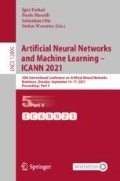Abstract
Appearance-based person re-identification is very challenging, i.a. due to changing illumination, image distortion, and differences in viewpoint. Therefore, it is crucial to learn an expressive feature embedding that compensates for changing environmental conditions. There are many loss functions available to achieve this goal. However, it is hard to judge which one is the best. In related work, the experiments are only performed on the same datasets, but the use of different setups and different training techniques compromises the comparability. Therefore, we compare the most widely used and most promising loss functions under identical conditions on three different setups. We provide insights into why some of the loss functions work better than others and what additional benefits they provide. We further propose sequential training as an additional training trick that improves the performance of most loss functions. In our conclusion, we provide guidance for future usage an d research regarding loss functions for appearance-based person re-identification. Source code is available (Source code: https://www.tu-ilmenau.de/neurob/data-sets-code/re-id-loss/).
This work has received funding from the Carl Zeiss Foundation as part of the project E4SM under grant agreement no. P2017-01-005.
Access this chapter
Tax calculation will be finalised at checkout
Purchases are for personal use only
Notes
- 1.
We also evaluated the performance on DukeMTMC-reID, and CUHK03-NP, but since the results are very similar and due to space restrictions, we decided in favor of reporting only the Market-1501 results in this paper.
- 2.
The standard deviation for 8 training runs of the best loss function in each case is \(\sigma _{mAP} = 0.226\%,\, \sigma _{r1} = 0.418\%\) for the baseline setup, \(\sigma _{mAP} = 0.079\%,\, \sigma _{r1} = 0.114\%\) for the strong baseline, and \(\sigma _{mAP} = 0.046\%,\, \sigma _{r1} = 0.098\%\) for MGN.
- 3.
Results for THL (mAP: 79.38% and rank 1: 90.80%) are omitted in Fig. 3(d) for visualization purposes.
- 4.
The angles of AAML are shown instead of those of CirL, because here the margin of AAML to be learned can be better visualized.
References
Bridle, J.S.: Training stochastic model recognition algorithms as networks can lead to maximum mutual information estimation of parameters. In: NIPS (1990)
Deng, J., et al.: ArcFace: additive angular margin loss for deep face recognition. In: CVPR (2019)
Fan, X., et al.: SphereReID: deep hypersphere manifold embedding for person re-identification. In: JVCIR (2019)
Hermans, A., et al.: In defense of the triplet loss for person re-identification. arXiv (2017)
Jia, J., et al.: Frustratingly easy person re-identification: generalizing person re-id in practice. In: BMVC (2019)
Jie, S., et al.: A new discriminative feature learning for person re-identification using additive angular margin softmax loss. In: UCET (2019)
Jin, H., et al.: Deep person re-identification with improved embedding and efficient training. In: IJCB (2017)
Liu, W., et al.: Large-margin softmax loss for convolutional neural networks. In: ICML (2016)
Liu, W., et al.: SphereFace: deep hypersphere embedding for face recognition. In: CVPR (2017)
Luo, H., et al.: Bag of tricks and a strong baseline for deep person re-identification. In: CVPRW (2019)
Schroff, F., et al.: FaceNet: a unified embedding for face recognition and clustering. In: CVPR (2015)
Sun, Y., et al.: Circle loss: a unified perspective of pair similarity optimization. In: CVPR (2020)
Wang, F., et al.: Additive margin softmax for face verification. SPL 25(7), 926–930 (2018)
Wang, G., et al.: Learning discriminative features with multiple granularities for person re-identification. In: ICM (2018)
Wang, H., et al.: CosFace: large margin cosine loss for deep face recognition. In: CVPR (2018)
Wen, Y., Zhang, K., Li, Z., Qiao, Yu.: A discriminative feature learning approach for deep face recognition. In: Leibe, B., Matas, J., Sebe, N., Welling, M. (eds.) ECCV 2016. LNCS, vol. 9911, pp. 499–515. Springer, Cham (2016). https://doi.org/10.1007/978-3-319-46478-7_31
Xiong, F., et al.: Good practices on building effective CNN baseline model for person re-identification. In: ICGIP (2019)
Zheng, L., et al.: Scalable person re-identification: a benchmark. In: ICCV (2015)
Zheng, Y., et al.: Ring loss: convex feature normalization for face recognition. In: CVPR (2018)
Author information
Authors and Affiliations
Corresponding author
Editor information
Editors and Affiliations
Rights and permissions
Copyright information
© 2021 Springer Nature Switzerland AG
About this paper
Cite this paper
Aganian, D., Eisenbach, M., Wagner, J., Seichter, D., Gross, HM. (2021). Revisiting Loss Functions for Person Re-identification. In: Farkaš, I., Masulli, P., Otte, S., Wermter, S. (eds) Artificial Neural Networks and Machine Learning – ICANN 2021. ICANN 2021. Lecture Notes in Computer Science(), vol 12895. Springer, Cham. https://doi.org/10.1007/978-3-030-86383-8_3
Download citation
DOI: https://doi.org/10.1007/978-3-030-86383-8_3
Published:
Publisher Name: Springer, Cham
Print ISBN: 978-3-030-86382-1
Online ISBN: 978-3-030-86383-8
eBook Packages: Computer ScienceComputer Science (R0)

